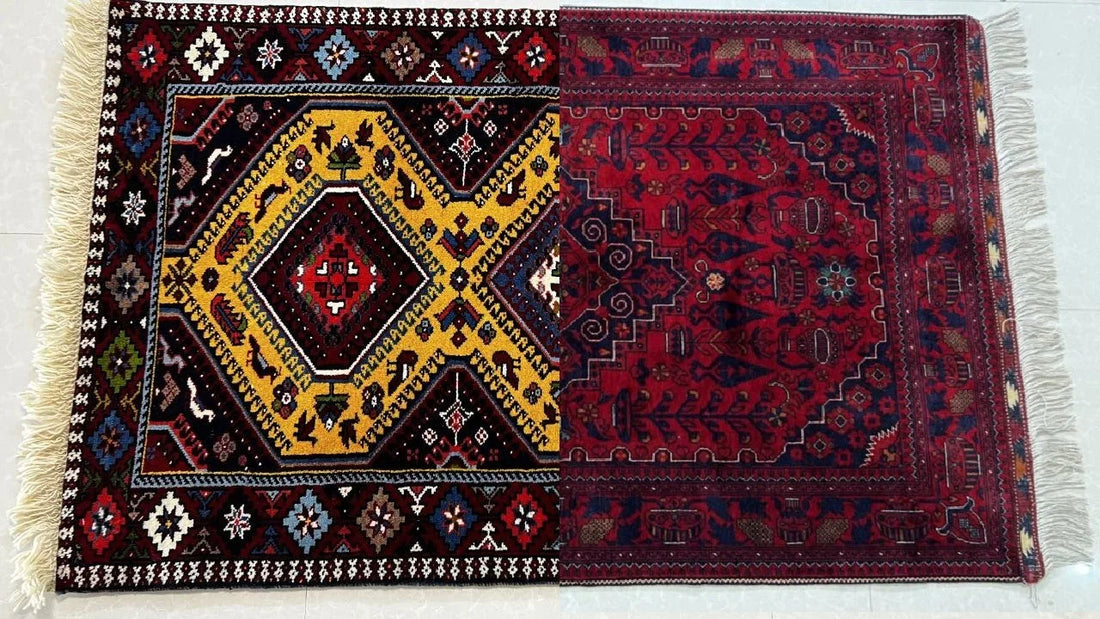Table of Contents
From the nomadic routes of Fars to the northern weaving towns of Afghanistan, handmade rugs tell stories far beyond their patterns—they speak of journeys, identities, and a deep-rooted bond with land and heritage. In this article, we explore two distinct traditions: the lyrical, free-spirited Qashqai rug of southern Iran and the bold, geometric elegance of the Khan Mohammadi rug, originally woven across Afghan plains. Each is a masterpiece shaped by its people, purpose, and place.
The Qashqai Rug: A Story Woven in Thread
In the vast southern plains of Iran, where the Qashqai nomads breathe in rhythm with the land, a rug is born—not merely an ornament for homes, but a living archive of memories, culture, and the myths of a people. The Qashqai rug is not just a woven piece; it is a testament to a nomadic life, to indigenous aesthetics, and to an unbreakable bond with nature.
Heritage and Heartland
The Qashqai people, a Turkic-speaking tribe with a history spanning centuries, have long inhabited the regions of Fars, Kohgiluyeh, Bushehr, and parts of Isfahan. For generations, they wove carpets not for commerce alone, but for life itself.
Traditionally woven on portable horizontal looms, Qashqai rugs evolved—particularly from the Qajar era onward—as some families settled and began producing larger, more refined pieces.
Color: The Language of Nature
- Pomegranate red (madder root): passion and grounding
- Indigo blue: calm, wisdom, and the infinite sky
- Saffron yellow: joy and energy
- Olive green: growth, fertility, balance
- Earth tones: honesty, humility
These hues reflect the land, the light, and the Qashqai spirit itself.
Motifs as Cultural Storytelling
Free-form and intuitive, Qashqai designs speak without words:
- Mountain goats: resilience and independence
- Eight-pointed stars: cosmic harmony
- Birds in flight: migration, freedom
- Empty spaces: like pauses in music—silent yet essential
Each rug carries the rhythm of a lived, mobile life.
A Way of Life, Woven in Thread
The Qashqai rug doesn’t just have a design—it has a personality. Its wool comes from sheep that graze in the Zagros Mountains. Its colors are made from plants carefully gathered by hand. Every knot tells a story of migration, mourning, celebration, or prayer.
While the Qashqai rug speaks with lyrical spontaneity, the Khan Mohammadi rug brings a different energy—bold, structured, and luminous. It emerges not from migration but from settled village life, and its patterns bridge tradition and refinement.
Khan Mohammadi Carpet: The Dignity of Afghanistan in a Living Weave
Though popularly associated with eastern Iran due to market circulation, the Khan Mohammadi rug originates from northern Afghanistan—especially the regions around Kunduz and Andkhoy. It emerged in the mid-20th century as a distinctive style rooted in Turkmen and Afghan weaving traditions. Over time, its bold motifs, deep color palette, and durable weave gained attention in Iranian and international markets. The name "Khan Mohammadi" was likely adopted by traders and exporters, contributing to its recognition and evolution across borders.
Origins and Historical Background
The design matured in the second half of the 20th century. Influenced by Turkmen and traditional Khorasani motifs, Khan Mohammadi rugs developed their own distinct visual identity and technical refinement, eventually earning recognition in major markets.
Color Symbolism and Palette Philosophy
Bold, radiant, and expressive:
- Laki (red): passion and intensity
- Deep indigo: focus and mystery
- Ivory: balance and purity
- Olive green & black: grounding the eye
- Golden orange: the Khorasani sun captured in wool
Sun-fixed and naturally dyed, these hues deepen over time like fine aged fabric.
Motifs and Decorative Elements
While still intuitive, these designs are more geometric and ordered:
- Serrated medallions: strength and structure
- Eight-pointed stars: protection and harmony
- Zigzag borders: motion, rhythm, migration
- Layered frames: inner and outer worlds, spiritual boundaries
Each rug offers both visual boldness and symbolic subtlety.
Structure, Knot, and Wool
Using high-quality hand-spun wool and Turkmen knots, these rugs have a strong and precise structure that ensures exceptional durability. Even the back of the rug is very neat and clean, showcasing the weaver’s skill and finesse.
Though different in rhythm and tone, the Qashqai and Khan Mohammadi rugs share a deeper common ground: a reverence for craft, a closeness to land, and an unspoken poetry expressed through color, motif, and form.
One is a song of movement.
The other, a hymn of stillness.
Each one is a storyteller of the enduring beauty of Iranian and Afghan cultures — a beauty woven beyond thread, with spirit and soul.
We’d love to hear your thoughts—please leave a review and let us know what this piece meant to you.





